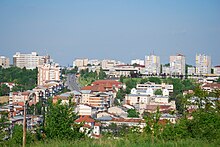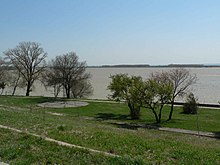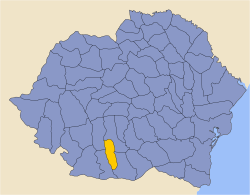| Olt County Județul Olt | |
|---|---|
| County | |
 Coat of arms Coat of arms | |
 | |
| Country | Romania |
| Development region | Sud-Vest |
| Historical region | Wallachia |
| Capital | Slatina |
| Government | |
| • President of the County Board | Marius Oprescu [ro] (PSD) |
| • Prefect | Stefan Nicolae [ro] |
| Area | |
| • Total | 5,498 km (2,123 sq mi) |
| • Rank | 22nd |
| Population | |
| • Total | 383,280 |
| • Rank | 19th |
| • Density | 70/km (180/sq mi) |
| Telephone code | (+40) 249 or (+40) 349 |
| ISO 3166 code | RO-OT |
| GDP (nominal) | US$ 2.158 billion (2015) |
| GDP per capita | US$ 5,194 (2015) |
| Website | County Council Prefecture |
Olt County (Romanian pronunciation: [olt]) is a county (județ) of Romania on the border with Bulgaria, in the historical regions of Oltenia and Muntenia (the regions are separated by the Olt river). The capital city is Slatina.
History
On 24 August 2017, the Olt County Council decided to hold a name referendum on 15 October 2017 for the proposal to change the county name to "Olt-Romanați". The referendum was eventually held on 6 and 7 October 2018. The vote was nullified, as turnout was 27.19%, below the required threshold of 30%; therefore, the Olt County retains its current name.
Demographics
In 2011, the county had a population of 415,530 and the population density was 75.57/km (195.7/sq mi).
| Year | County population |
|---|---|
| 1948 | 442,442 |
| 1956 | 458,982 |
| 1966 | 476,513 |
| 1977 | 518,804 |
| 1992 | 520,966 |
| 2002 | 489,274 |
| 2011 | 415,530 |
| 2021 | 383,280 |
The county is a mainly rural one, with over 60% of the population living in villages.
Geography
The county lies in a flat area on the western part of the Romanian Plain. It is crossed by rivers from north to south, including the Olt River which gave the county its name. The Danube forms a wide valley in the south, with many ponds and small channels, which are occasionally flooded.
Neighbours
 AB
AR
AG
BC
BH
BN
BT
BV
BR
BZ
CS
CL
CJ
CT
CV
DB
DJ
GL
GR
GJ
HR
HD
IL
IS
IF
MM
MH
MS
NT
OT
PH
SM
SJ
SB
SV
TR
TM
TL
VS
VL
VN
B
AB
AR
AG
BC
BH
BN
BT
BV
BR
BZ
CS
CL
CJ
CT
CV
DB
DJ
GL
GR
GJ
HR
HD
IL
IS
IF
MM
MH
MS
NT
OT
PH
SM
SJ
SB
SV
TR
TM
TL
VS
VL
VN
B
- Teleorman County to the East.
- Dolj County to the West.
- Argeș County and Vâlcea County to the North.
- Bulgaria to the South - Vratsa Province and Pleven Province.
Economy
The predominant industries in the county are:
- Metallurgy - aluminium and aluminium components.
- Railway equipment.
- Food and beverages industry.
- Textile industry.
- Mechanical components industry.
Agriculture is the main occupation in the county - over 58% of the population having agriculture as their main occupation. Both extensive agriculture, and small-scale, vegetables and fruits, are practiced. The area is well suited for irrigation.
Tourism
The main destinations for tourists are:
- The city of Slatina.
- Fishing on the Danube and on the Olt River.
- Town of Corabia with an ancient Roman citadel, a large orthodox cathedral, Danube sunbathes, sailing and fishing.
- The town of Scornicești - the birthplace of Nicolae Ceaușescu.
Politics
The Olt County Council, renewed at the 2020 local elections, consists of 32 counsellors, with the following party composition:
| Party | Seats | Current County Council | |||||||||||||||||||||
|---|---|---|---|---|---|---|---|---|---|---|---|---|---|---|---|---|---|---|---|---|---|---|---|
| Social Democratic Party (PSD) | 21 | ||||||||||||||||||||||
| National Liberal Party (PNL) | 11 | ||||||||||||||||||||||
Administrative divisions




Olt County has 2 municipalities, 6 towns and 104 communes:
- Communes
- Băbiciu
- Baldovinești
- Bălteni
- Bărăști
- Bârza
- Bobicești
- Brâncoveni
- Brastavățu
- Brebeni
- Bucinișu
- Cârlogani
- Călui
- Cezieni
- Cilieni
- Colonești
- Corbu
- Coteana
- Crâmpoia
- Cungrea
- Curtișoara
- Dăneasa
- Deveselu
- Dobrețu
- Dobrosloveni
- Dobroteasa
- Dobrun
- Drăghiceni
- Făgețelu
- Fălcoiu
- Fărcașele
- Găneasa
- Găvănești
- Gârcov
- Giuvărăști
- Ghimpețeni
- Gostavățu
- Grădinari
- Grădinile
- Grojdibodu
- Gura Padinii
- Ianca
- Iancu Jianu
- Icoana
- Ipotești
- Izbiceni
- Izvoarele
- Leleasca
- Mărunței
- Mihăești
- Milcov
- Morunglav
- Movileni
- Nicolae Titulescu
- Obârșia
- Oboga
- Oporelu
- Optași-Măgura
- Orlea
- Osica de Sus
- Osica de Jos
- Pârșcoveni
- Perieți
- Pleșoiu
- Poboru
- Priseaca
- Radomirești
- Redea
- Rotunda
- Rusănești
- Sâmburești
- Sârbii-Măgura
- Scărișoara
- Schitu
- Seaca
- Șerbănești
- Slătioara
- Șopârlița
- Spineni
- Sprâncenata
- Ștefan cel Mare
- Stoenești
- Stoicănești
- Strejești
- Studina
- Tătulești
- Teslui
- Tia Mare
- Topana
- Traian
- Tufeni
- Urzica
- Vădastra
- Vădăstrița
- Vâlcele
- Valea Mare
- Văleni
- Verguleasa
- Vișina
- Vișina Nouă
- Vitomirești
- Vlădila
- Voineasa
- Vulpeni
- Vulturești
Historical county
County in Romania| Județul Olt | |
|---|---|
| County (Județ) | |
 The Olt County Prefecture's building from the interwar period, currently the Olt County Museum. The Olt County Prefecture's building from the interwar period, currently the Olt County Museum. | |
 Coat of arms Coat of arms | |
 | |
| Country | |
| Historic region | Muntenia |
| Capital city (Reședință de județ) | Slatina |
| Area | |
| • Total | 2,863 km (1,105 sq mi) |
| Population | |
| • Total | 183,595 |
| • Density | 64/km (170/sq mi) |
| Time zone | UTC+2 (EET) |
| • Summer (DST) | UTC+3 (EEST) |
Historically, the county was located in the southern part of Greater Romania, in the western part of the historical region of Muntenia, around and in the south of Bucharest. The county included the north-eastern part of the current Olt county, the south-western part of the present Argeș County and the north-western part of the present Teleorman County. During the interwar years, it was bordered to the north by Argeș County, to the east by the counties of Argeş and Teleorman, to the south by Teleorman County, and in the west by the counties of Romanați and Vâlcea.
Administration

The county originally was divided into three administrative districts (plăși):
- Plasa Drăgănești, headquartered at Drăgănești
- Plasa Dumitrești, headquartered at Dumitrești
- Plasa Spineni, headquartered at Spineni
Subsequently, the county established an additional district:
- Plasa Mijlocul, headquartered at Mijlocul
Population
According to the 1930 census data, the county population was 183,595 inhabitants, ethnically divided as follows: 98.2% Romanians, 1.2% Romanies, as well as other minorities. From the religious point of view, the population was 99.5% Eastern Orthodox, 0.2% Roman Catholic, 0.1% Jewish, as well as other minorities.
Urban population
In 1930, the county's urban population was 11,243 inhabitants, comprising 92.5% Romanians, 2.5% Hungarians, 1.5% Jews, 0.8% Germans, as well as other minorities. From the religious point of view, the urban population was composed of 94.1% Eastern Orthodox, 2.3% Roman Catholic, 1.6% Jewish, 0.9% Reformed, 0.6% Lutheran, as well as other minorities.
References
- "Populaţia rezidentă după grupa de vârstă, pe județe și municipii, orașe, comune, la 1 decembrie 2021" (XLS). National Institute of Statistics.
- The number used depends on the numbering system employed by the phone companies on the market.
- "Olt: CJ a programat pe 15 octombrie referendumul pentru schimbarea numelui județului" (in Romanian). Agerpres. 24 August 2017. Retrieved 3 September 2017.
- Dorobanțu, Alin (19 September 2018). ""DA", pentru Olt-Romanați!". Ziarul de Olt (in Romanian).
- "Referendumul din Olt a eșuat, deși prezența a fost mai mare decât la referendumul pentru familie" (in Romanian). Libertatea. 7 October 2018. Retrieved 6 November 2018.
- National Institute of Statistics, "Populația după etnie" Archived 2009-08-16 at the Wayback Machine
- National Institute of Statistics, "Populația la recensămintele din anii 1948, 1956, 1966, 1977, 1992 și 2002" Archived 2006-09-22 at the Wayback Machine
- "Rezultatele finale ale alegerilor locale din 2020" (Json) (in Romanian). Autoritatea Electorală Permanentă. Retrieved 2020-11-02.
- Portretul României Interbelice - Județul Olt
44°26′00″N 24°22′00″E / 44.4333°N 24.3667°E / 44.4333; 24.3667
Categories:- Olt County
- Counties of Romania
- Geography of Wallachia
- 1879 establishments in Romania
- 1938 disestablishments in Romania
- 1940 establishments in Romania
- 1950 disestablishments in Romania
- 1968 establishments in Romania
- States and territories established in 1879
- States and territories disestablished in 1938
- States and territories established in 1940
- States and territories disestablished in 1950
- States and territories established in 1968
